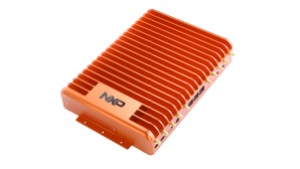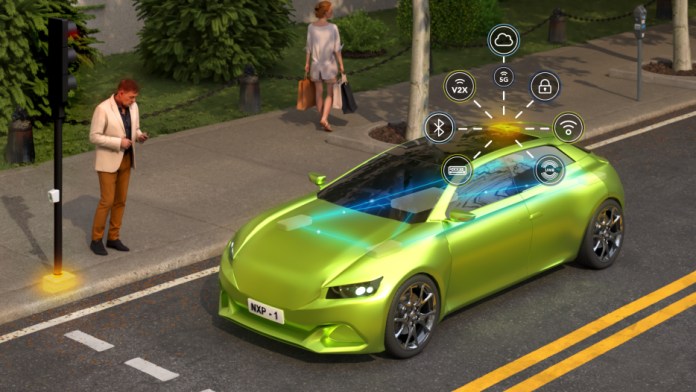NXP Semiconductors recently introduced its OrangeBox automotive-grade development platform, which combines all wireless and wired connectivity solutions for a vehicle in a single connectivity domain controller. Designed to streamline development and security via a centralized domain-based architecture, the platform integrates a variety of NXP wireless technologies, including broadcast radio, Wi-Fi 6, and Bluetooth as well as secure car access with ultra-wideband (UWB) and Bluetooth Low Energy (BLE), and 802.11p-based V2X.

OrangeBox development platform for an automotive connectivity domain controller (Source: NXP Semiconductors)
OrangeBox is a development platform for a connectivity domain controller where all of the wireless interfaces in the car are all concentrated in one box with a single processor, said Jim Bridgwater, director of NXP’s automotive edge processing product line.
There are a lot of different wireless technologies in the car these days – Wi-Fi and Bluetooth – but also V2X and cellular, and all of them are in one place in a single domain controller, Bridgwater explained. The idea is to make it much easier to have a good cybersecurity solution when all of the wireless interfaces for the external world are coming through one place, and also to manage things like RF coexistence, he added.
NXP describes OrangeBox as “a single, security enhanced, modular development platform that provides a unified interface between the vehicle’s gateway and its wired and wireless technologies.” The platform addresses the design challenges of connected cars that use a variety of wireless technologies and require advanced security to protect against cyberattacks, which are typically distributed throughout a vehicle’s architecture.
By unifying the external wireless interfaces into a single, secure connectivity domain controller, which connects to the secure vehicle gateway through NXP’s high-speed Ethernet, the turn-key platform reduces the development effort. This allows security protection to be applied to all traffic coming into the car, while making it easier to deploy V2X and cloud applications, including over-the-air (OTA) updates for software-defined vehicles.
It also makes it easier for automakers to use cloud-managed security technologies, such as next-generation firewalls, for data traffic entering or leaving the vehicle.

The OrangeBox automotive platform unifies all wireless technologies in a single box to simplify development and security. (Source: NXP Semiconductors)
Another benefit for OEMs and Tier-1s is that they can adapt the modular platform to different regional requirements for cellular connectivity and V2X, as well as enable in-field updates. The benefits include a faster time-to-market, lower design complexity, and the availability of a complete system reference design that can be used in multiple car architectures.
“It’s important to work with all of them [OEMs and Tier-1s],” said Bridgwater. “OrangeBox provides a platform that we can give to the Tier-1s, OEMs, and third parties with all of these wireless technologies integrated. They can start porting their applications, check out the use cases, prove that this can work, and address some of the challenges with it.
“Our expectation is that third parties are going to port their cybersecurity and other types of apps onto this so that it becomes more of an ecosystem of solutions that can be used by customers,” he added.
Bridgwater is starting to see the trend in the automotive industry to centralize all of the wireless technologies for a couple of reasons, which includes addressing RF coexistence and cybersecurity challenges. He believes cybersecurity may be the killer app for the connectivity domain controller.
“Part of this connectivity domain controller is shifting the architecture to be more like an enterprise security approach where you’re checking all of the traffic that’s coming into the enterprise or in this case the car,” he said. “We think this evolution to a connectivity domain controller has started and makes sense for the industry and we’re trying to facilitate that with the OrangeBox development platform.”
There has been a lot of growth in use cases for wireless connectivity in the car, Wi-Fi and Bluetooth, but also V2X as well as UWB and NFC, and for a long-time broadcast radio and digital radio technologies, said Bridgwater. The use cases are multiplying such as Apple CarPlay and Android Auto; in-cabin and rearview cameras; audio streaming to headsets, gaming, EV charging, and even home control when the car is parked outside the home, he added.
“The challenge with this system is that all of these different ways of connecting with the outside world historically have been kind of bolted onto the different ECUs in the car and so they are distributed around the vehicle electrical architecture, and it causes a couple of problems,” he said.
One of the biggest challenges is security. “Cybersecurity is becoming very important in the automotive industry and having all of these wireless technologies distributed makes it challenging to protect the car from malicious code getting into it,” he said.
“In this connectivity domain controller there is a powerful processor which is able to run state-of-the-art security – next-generation firewall technology, which is regularly updated via the cloud so that you can patch your security technology and have the best protection against the car getting a cyberattack,” he added. “Obviously, no security solution is perfect. You still need to be monitoring the internal networks via something like our S32G [vehicle network processor] system which would be sitting in a vehicle networking box, but if you can at least stop the majority of the malware getting in that seems like the best way to protect the car.”
The connectivity domain controller architecture also puts all of these RF technologies in one place to work on RF coexistence,” he added. “Some of them are cohabiting the same bands, so you want to be able to have them work cooperatively and putting them all in one place makes that much easier.”
What’s in the OrangeBox
The development platform consists of a variety of NXP technologies, including an advanced applications processor, a software-defined broadcast radio tuner, Wi-Fi 6, and Bluetooth. It also includes secure car access with BLE and UWB, as well as 802.11p-based V2X, both secured by certified EdgeLock discrete NXP secure elements. It also supports 4G LTE, 5G cellular and GPS connectivity.
At the center of the OrangeBox is an i.MX 8XLite applications processor with support for V2X and telematics running a unified Linux-based software platform to manage the automotive wireless connectivity. It includes an NXP gigabit Ethernet connection to the central vehicle gateway.
This design also has a S32K safety MCU, which provides ASIL-B capability, along with secure access (BLE and UWB), audio technology, the Ethernet switch and PHYs, as well as DSRC and V2X capabilities, broadcast radio, and variety of power management ICs, said Bridgwater.
NXP has done the entire hardware design and also the pre-integration of all the drivers and integrated it into Linux and AUTOSAR, which “is a lot of work that will save our customers a lot of time,” he said.
Bridgwater noted that the OrangeBox also supports the automotive industry’s move to software-defined cars.
“The software-defined vehicle is very much about this kind of architecture with a few large nodes that have responsibility for many functions that are connected by Ethernet,” he said. “We’re simplifying that with all the wireless [technologies] in one place. This is a modular wireless connectivity box, which you can plug into your software-defined-vehicle architecture. You can have more or less features in it, but it is very much part of that modular architecture that can be easily upgraded with software and managed by the OEMs.”
The OrangeBox automotive development platform will be available in the first half of 2023. NXP will demonstrate the platform at CES 2023 (#CP-18).
Advertisement
Learn more about NXP Semiconductors






